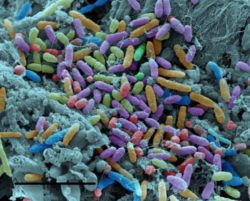Microbiomics
‘Microbiomics’ is a fast-growing field in which all the microorganisms of a given community (a ‘microbiota’) are investigated together. This could be the microbiota of an environmental sample (e.g. soil or water), a particular body site (e.g. the gut or the mouth) or from a particular organism (e.g. farm or zoo animals).
Investigation of environmental microbial communities can be of particular interest in discovery of ‘novel’ organisms with exciting properties, such as production of natural products with antimicrobial properties. Research into farm animal gut microbiota has the  potential to help the agricultural industry improve growth of animals whilst reducing excess antibiotic use (an important driver of antimicrobial resistance), and research groups investigating the human ‘commensal’ microbiota (the ‘normal’ microflora associated with our bodies) are exploring the many potential roles these organisms play in health and disease, and how disruption of these microbial communities can affect our wellbeing.
potential to help the agricultural industry improve growth of animals whilst reducing excess antibiotic use (an important driver of antimicrobial resistance), and research groups investigating the human ‘commensal’ microbiota (the ‘normal’ microflora associated with our bodies) are exploring the many potential roles these organisms play in health and disease, and how disruption of these microbial communities can affect our wellbeing.
Microbiota profiling
At the simplest level, microbiomics looks to investigate the make-up of a particular microbial community and how this might change over time, or with particular pressure. This is typically done using 16S profiling. DNA is extracted from the target sample (soil / water / faeces) and the 16S RNA gene amplified using the polymerase chain reaction (PCR). The resulting amplified DNA fragments are sequenced, and can be matched against sequence databases to achieve identifications of the organisms present. This can give a ‘snapshot’ of the communities present in a sample at any given time, and can be used to compare the communities in different samples, or follow changes in the communities of a particular sample site over time.
The Healthcare Associated Infection Research Group at Leeds is interested in the gut microbiome, and how the ‘normal’ communities of the gut interact with potentially harmful bacteria such as Clostridium difficile and Multi Drug Resistant Enterobacteriaceae (MDRE). We use an artificial human gut system to model the bacterial populations of the gut and to investigate changes to these populations following interventions such as exposure to antibiotics.
Meta-Omics
Rapid development of high throughput molecular methods has made it possible to carry out detailed investigations of the microbiota with regards to their genetic and functional diversity, providing a better understanding of what species are present, how they relate to each other, what genes are expressed and what metabolic activities are undergoing. Various platforms enabling these technologies (Illumina, 454 Roche, PacBio, Oxford Nanopores etc) now allow the study of metagenomics (all the genes in a given sample), metatranscriptomics (the gene expression (mRNA) in a given sample), metaproteomics (all the proteins in a given sample) and metametabolomics (all the metabolites in a given sample), exploring the biological signatures that are associated with specific environments.
The Microbiology and Cell Biology Group (School of Dentistry, Leeds) aims to investigate host-microbiome interactions to understand the role of the microbiome and host responses in health and infectious diseases. The research group employs an interdisciplinary approach to decipher the links between oral health and systemic health or diseases, using various biofilm models and clinical samples, making use of our state of the art Leeds Dental Translational and Clinical Research Unit facility. For example, we are working on various projects exploring links between periodontitis and arthritis and diabetes.
